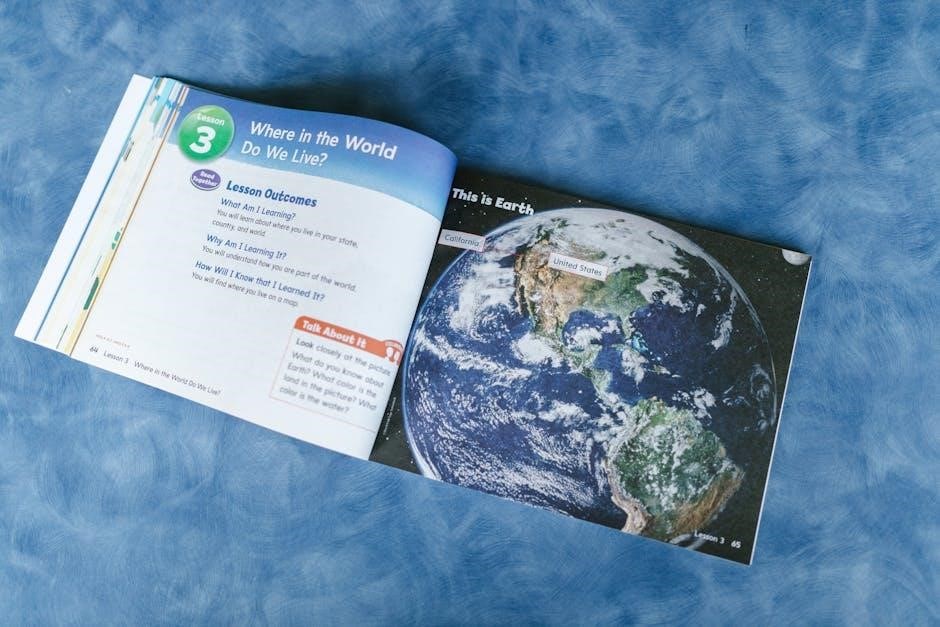This textbook offers a comprehensive global perspective‚ exploring historical events and cultural interactions. Its PDF format enhances accessibility‚ making it ideal for both classroom and self-study environments.
1.1 Overview of the Textbook
“The Ways of the World” textbook provides a comprehensive exploration of global history‚ emphasizing connections and interactions across cultures; Organized chronologically‚ it covers key historical periods‚ from ancient times to the modern era. The PDF version incorporates vibrant maps‚ charts‚ and primary sources‚ enhancing visual learning. Designed for students and educators‚ it offers a flexible and engaging approach to understanding global perspectives‚ making it an invaluable resource for both classroom instruction and independent study.
1.2 Importance of the PDF Version
The PDF version of “The Ways of the World” textbook offers unparalleled convenience and accessibility. It allows users to easily search‚ highlight‚ and annotate content‚ enhancing study efficiency. The digital format ensures portability across devices‚ making it ideal for on-the-go learning. Additionally‚ the PDF preserves the textbook’s visual elements‚ such as maps and charts‚ ensuring an engaging and immersive learning experience. This format is particularly beneficial for students and educators seeking flexibility in their academic resources.

Content Structure of the Textbook
The textbook is organized into thematic chapters‚ each exploring key historical periods and cultural interactions. Its logical structure facilitates a deep understanding of global history and its interconnectedness.
2.1 Chapters and Themes Covered
The Ways of the World textbook is divided into chapters that explore major historical periods‚ from the emergence of human societies to modern globalization. Themes include the development of agriculture‚ the rise of cities‚ and the impact of trade‚ religion‚ and technology on cultural exchange. Each chapter highlights how global interactions have shaped societies‚ emphasizing the interconnectedness of human history. The text incorporates case studies and primary sources to illustrate key themes‚ providing a rich and nuanced understanding of the past.
2.2 Key Historical Periods Explored
The textbook spans from ancient civilizations to modern globalization‚ covering pivotal periods like the rise of empires‚ the Middle Ages‚ and the Industrial Revolution. It explores the interconnectedness of global events‚ such as trade networks‚ cultural exchanges‚ and technological advancements. Each era is examined to highlight its impact on shaping the contemporary world‚ offering insights into how historical developments influence current societal structures and global interactions.

Authors and Contributors
The textbook is authored by renowned historians‚ including Robert W. Strayer‚ who bring extensive knowledge to the narrative. Contributors from various fields enrich its global perspective through collaborative efforts.
3.1 Background of the Authors
Robert W. Strayer‚ the primary author‚ holds a Ph.D. in African and European history‚ bringing deep expertise to the textbook; His academic career spans decades‚ with contributions to numerous historical works. Other contributors include specialists in Asian‚ American‚ and Middle Eastern history‚ ensuring a diverse and well-rounded perspective. Their collective experience in teaching and research enhances the textbook’s credibility and depth‚ offering students a rich understanding of global history. Their work is widely recognized for its clarity and engagement.
3.2 Expertise in World History
The authors are renowned experts in world history‚ with specialized knowledge across various regions and time periods. Their expertise ensures a balanced and comprehensive narrative‚ bridging gaps between global events and local contexts. By integrating diverse perspectives‚ they provide insights into cultural‚ social‚ and political developments. This collaborative approach enriches the textbook‚ making it a trusted resource for understanding the complexities of global history. Their expertise is evident in the thorough research and engaging presentation of historical content.

Target Audience
This textbook is designed for students‚ educators‚ and self-learners interested in world history. It caters to diverse learning needs‚ offering accessible and in-depth content for global understanding and education.
4.1 Ideal for Students and Educators
The textbook is tailored for students seeking a robust understanding of global history and educators needing a reliable resource. It provides structured content‚ making it easy to integrate into curricula. Visual aids and primary sources enhance learning‚ while the PDF format allows easy access and sharing. Educators can use it to create engaging lesson plans‚ and students can benefit from its comprehensive coverage of historical periods and themes. This makes it an essential tool for both teaching and learning environments.
4.2 Suitability for Self-Study
The PDF version of “The Ways of the World” is highly suitable for self-study due to its clear structure and organized content. The digital format allows easy navigation‚ with features like search and highlighting enabling efficient learning. Supplementary materials‚ such as study guides and workbooks‚ further support independent study. The textbook’s comprehensive coverage of historical periods and themes ensures a well-rounded understanding‚ making it an excellent resource for learners studying without direct supervision.

Special Features of the Textbook
The textbook includes maps‚ charts‚ and visual aids to enhance understanding. Primary sources and historical documents provide authentic insights‚ enriching the learning experience for students.
5.1 Maps‚ Charts‚ and Visual Aids
The textbook incorporates detailed maps‚ charts‚ and visual aids to illustrate historical events and cultural interactions. These elements help students visualize complex processes‚ such as trade routes‚ empires’ expansions‚ and technological advancements. High-quality images and diagrams are strategically placed to complement the narrative‚ making abstract concepts more tangible. The visuals also highlight key themes like environmental changes and social hierarchies‚ providing a multidimensional understanding of global history.
5.2 Primary Sources and Historical Documents
The textbook integrates primary sources‚ such as letters‚ treaties‚ and images‚ to provide firsthand insights into historical events. These documents allow students to analyze the perspectives of individuals from diverse cultures and time periods. By including these materials‚ the text encourages critical thinking and connects students directly to the past. The sources are carefully selected to align with key themes and events‚ making history more engaging and accessible for learners.

Benefits of the PDF Format
The PDF version offers unparalleled accessibility and convenience‚ enabling easy highlighting and searching. It ensures consistent formatting across devices‚ making it ideal for both academic and personal use.
6.1 Accessibility and Convenience
The PDF format of “The Ways of the World” textbook ensures accessibility across various devices‚ allowing students to study anytime‚ anywhere. Its portability and convenience make it ideal for modern learners who value flexibility. The digital version eliminates the need for physical storage‚ enabling easy access on laptops‚ tablets‚ and smartphones. This convenience is particularly beneficial for students juggling multiple responsibilities‚ as it facilitates seamless transitions between study environments. Moreover‚ the PDF preserves the textbook’s layout and clarity‚ ensuring an optimal learning experience regardless of the device used. This accessibility feature is a significant advantage for both students and educators‚ promoting engagement and efficiency in academic pursuits.
6.2 Searchability and Highlighting Features
The PDF version of “The Ways of the World” textbook offers robust search functionality‚ enabling users to quickly locate specific terms or concepts. This feature is particularly useful for studying and research‚ as it saves time and enhances focus. Additionally‚ the ability to highlight and annotate text allows learners to engage actively with the material‚ marking important passages for later review. These tools not only improve retention but also make the learning process more interactive and efficient‚ catering to diverse study preferences and needs.

How to Download the PDF Version
To download the PDF version‚ visit the official publisher’s website or authorized online retailers. Ensure you access the file from legitimate sources to avoid unauthorized copies.
7.1 Legitimate Sources for Download
To ensure authenticity and legality‚ download the PDF version of “The Ways of the World” through the official publisher’s website or authorized online retailers like Amazon or Barnes & Noble. Additionally‚ many academic institutions provide access to digital versions through their libraries or online platforms. Always verify the source to avoid pirated copies‚ as they may contain inaccurate or incomplete content. Purchasing or accessing the PDF from legitimate sources supports the authors and ensures you receive a high-quality‚ updated version of the textbook.
7.2 Precautions Against Pirated Copies
When downloading the PDF version of “The Ways of the World”‚ ensure you purchase or access it from verified sources to avoid pirated copies. Avoid websites offering free downloads without verification‚ as they may contain malware or incomplete content. Always check for digital rights management (DRM) from the publisher or authorized sellers. Be cautious of unusually low prices and untrusted links‚ as they often lead to illegal distributions. Using pirated copies not only violates copyright laws but may also compromise your device’s security and provide an inferior learning experience.

Supplementary Materials
The textbook is supported by companion websites‚ study guides‚ and workbooks. These resources enhance learning through interactive tools‚ additional readings‚ and practice exercises‚ ensuring a comprehensive understanding of the material.
8.1 Companion Websites and Resources
The companion websites offer interactive tools‚ primary sources‚ and multimedia content. These resources include timelines‚ maps‚ and quizzes‚ designed to deepen understanding of historical events. Accessible online‚ they provide students with flexible learning options‚ enabling self-paced review and engagement. Educators can also utilize these resources to supplement lesson plans‚ ensuring a dynamic and enriched learning experience for all users.
8.2 Study Guides and Workbooks
Supplemental study guides and workbooks provide structured support for mastering the textbook content. These resources include practice questions‚ chapter summaries‚ and exercises tailored to reinforce key concepts. Workbooks often feature interactive activities‚ such as timelines‚ maps‚ and primary source analyses‚ to engage learners. Additionally‚ they offer tips for effective note-taking and exam preparation‚ helping students organize their studies and retain information more effectively. These tools are invaluable for both independent learners and classroom environments‚ ensuring a comprehensive understanding of the material.
Editions and Updates
The latest edition incorporates updated historical insights‚ enhanced digital features‚ and expanded primary sources‚ ensuring a more engaging and comprehensive learning experience for students.
9.1 Latest Edition Features
The latest edition of The Ways of the World introduces enhanced digital tools‚ including interactive maps and timelines. It features updated primary sources‚ improved visuals‚ and a focus on global connections. New chapters explore contemporary issues‚ providing students with a modern perspective. The PDF version includes searchable text and highlighting options‚ making it easier for learners to engage with the material. These updates ensure the textbook remains a leading resource for understanding world history.
9.2 Relevance of Updates
Regular updates ensure the textbook remains aligned with current historical research and educational standards. These revisions incorporate new discoveries and methodologies‚ providing students with accurate and up-to-date information. Updated content also reflects global shifts‚ making the material more relevant to contemporary learners. The inclusion of digital features enhances accessibility and engagement‚ meeting the evolving needs of both students and educators in an ever-changing academic landscape.

The Role of History in Education
History educates students about diverse cultures‚ societies‚ and global interactions. It fosters critical thinking‚ empathy‚ and a broader understanding of human experiences across time.
10.1 Understanding Global Perspectives
The textbook emphasizes the importance of understanding global perspectives by exploring diverse societies and their historical connections. It highlights how global interactions have shaped cultures‚ economies‚ and political systems. By examining these relationships‚ students gain empathy and a deeper understanding of the complexities of human history. This approach fosters critical thinking and prepares learners to engage with the challenges of an interconnected world. The content is enriched with primary sources and visual aids‚ making global perspectives accessible and engaging for students.
10.2 Interdisciplinary Connections
The textbook seamlessly integrates history with economics‚ culture‚ politics‚ and geography‚ showcasing how these disciplines interrelate. By connecting historical events to broader societal trends‚ it encourages students to think critically about the world’s complexity. Visual aids like maps and charts help illustrate these connections‚ making abstract concepts tangible. This interdisciplinary approach prepares learners to understand the multifaceted nature of global challenges and their historical roots‚ fostering a well-rounded educational experience.
User Reviews and Feedback
Students and educators praise the textbook for its clarity and engaging narrative style. Many highlight the PDF version’s accessibility and enhanced learning experience through visual aids and primary sources.
11.1 Student and Teacher Testimonials
Students and educators consistently praise the textbook for its engaging narrative and comprehensive coverage of global history. Many highlight its ability to connect diverse cultures and time periods seamlessly. The PDF version is particularly commended for its portability and accessibility‚ allowing learners to study anytime‚ anywhere. Teachers appreciate the inclusion of visual aids and primary sources‚ which enhance lesson planning and student engagement. Testimonials often emphasize how the textbook fosters a deeper understanding of historical contexts and their relevance to modern society.
11.2 Common Praise and Criticisms
The textbook is widely praised for its engaging narrative style and comprehensive coverage of global history. Users highlight its ability to connect diverse cultures and time periods effectively. The PDF version is lauded for its accessibility and convenience. However‚ some critics note the density of content as overwhelming for beginners. Additionally‚ the lack of interactive features in the PDF has been a point of contention. Despite this‚ the textbook remains a highly recommended resource for its balanced and insightful approach to world history.

Tips for Effective Study
Use the PDF’s search function to quickly locate key terms and concepts. Create chapter summaries and reference supplementary materials for deeper understanding. Engage actively with the content by highlighting and note-taking to reinforce retention.
12.1 Strategies for Retaining Information
Effective retention begins with active engagement. Use the PDF’s search function to locate key terms quickly. Create detailed chapter summaries to reinforce understanding. Engage in active learning by highlighting and taking notes. Review complex concepts regularly and test yourself on historical events and themes. Utilize visual aids like maps and charts to connect information visually. Discuss topics with peers or educators to deepen comprehension. Incorporate study guides and workbooks for additional practice and review.
12.2 Using the PDF for Active Learning
The PDF format enables interactive learning through its search function‚ allowing quick access to specific terms and concepts. Highlight key passages and take notes directly within the document for better engagement. Use the clear layout to follow historical narratives and analyze visual aids like maps and charts. Engage with primary sources to contextualize events and deepen understanding. The portability of the PDF ensures you can study anywhere‚ making active learning convenient and flexible.
Comparison with Other Textbooks
This textbook stands out for its comprehensive coverage of global history‚ offering unique insights and interactive features that enhance learning. Its PDF format ensures accessibility and convenience.
13.1 Unique Selling Points
The textbook’s unique selling points include its engaging narrative style‚ emphasis on global connections‚ and inclusion of primary sources. It offers a balanced approach to world history‚ integrating maps‚ charts‚ and visual aids to enhance understanding. The PDF version provides flexibility‚ allowing users to highlight and search content effortlessly. Additionally‚ its focus on critical thinking and interdisciplinary links sets it apart from competitors‚ making it a valuable resource for both students and educators seeking a comprehensive historical perspective.
13.2 Competitor Analysis
“The Ways of the World” stands out among other history textbooks for its unique narrative approach and global perspective. While competitors often focus on regional histories‚ this textbook seamlessly integrates global connections and cultural exchanges. Its use of primary sources and visual aids surpasses many alternatives‚ offering a more immersive learning experience. The PDF version’s searchability and accessibility further enhance its appeal‚ making it a preferred choice for students and educators seeking a comprehensive and engaging world history resource.
“The Ways of the World” textbook PDF is a valuable resource for understanding global history‚ offering comprehensive coverage and accessible learning tools that foster deeper engagement and knowledge retention.
14.1 Final Thoughts on the Textbook
“The Ways of the World” textbook PDF is a valuable resource for global history education‚ offering a comprehensive and accessible exploration of historical events. Its organized structure and engaging narrative make it ideal for students and educators alike. The inclusion of visual aids and primary sources enhances learning‚ while the PDF format ensures convenience and portability. This textbook not only educates but also fosters a deeper understanding of global perspectives‚ making it an essential tool for historical inquiry and interdisciplinary connections.
14.2 Encouragement for Further Reading
Exploring beyond the textbook enriches understanding of global history. Students are encouraged to delve into supplementary materials like companion websites and study guides. Engaging with primary sources and historical documents fosters critical thinking and a deeper appreciation for diverse cultures. Embrace the opportunity to expand knowledge by exploring interdisciplinary connections and staying updated with the latest historical research and perspectives.
